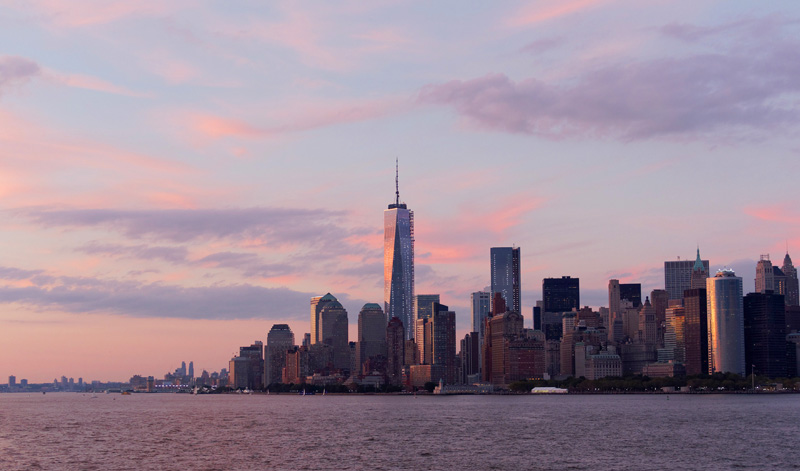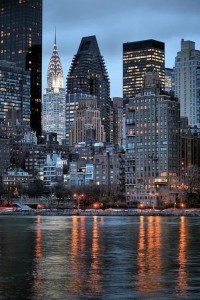
When you’re cruising out in New York Harbor, you’re immediately struck by the unique, astonishing Manhattan skyline. But the harbor itself has its own fascinating history.
New York Harbor is one of the largest natural harbors in the world; the largest oil importing port and third largest container port in the nation. The harbor begins at the mouth of the Hudson River, sharing waters of the Port of New York and New Jersey, through the Verrazano Narrows separating the Upper and Lower New York Bay spilling into the Atlantic Ocean.

Before its discovery in 1609 by English explorer Sir Henry Hudson, the Native American Indians used the waterways for fishing and travel. Back then, the clear waters were full of oysters, sturgeon, seals, porpoises, and whales. When Europeans first sailed through what is now the NY Harbor, they were struck by its sweet smell. The land was mountainous and rich with vegetation. The main island, originally “Manna-hata” (now known as Manhattan) was named by the Lenape Indians translated as ”island of many hills.” Situated in middle of waterways, it gave and still gives perfect access for ships and commerce.
From 1892 to 1954, Ellis Island, located in Upper New York Bay in the Port of New York and New Jersey, was the first stop for more than 12 million immigrants coming to America in search of a new life. Steamships would enter New York Harbor, passing through the Verrazano Narrows, past Governors Island, (a United States Army Post from 1766 to 1966), and the iconic Statue of Liberty – long a vision of hope, and an inspiration to immigrants from all over the globe.
As modern skyscrapers rose, bridges also connected Manhattan with the outer boroughs and New Jersey (Brooklyn, Manhattan, Williamsburg, Verrazano, and George Washington Bridges). These famous bridges are not only functional, but beautifully designed – especially at night when their garlands of lights shimmer in the waters below.
When sailing on the harbor, here are the most iconic sights to look out for:

One World Trade Center – The new building, dubbed the “Freedom Tower” during initial basework, refers to the main building of the new World Trade Center complex in Lower Manhattan. With 104 standard floors, it is the tallest skyscraper in the Western Hemisphere, and the fifth-tallest in the world. The construction of the new building, which may need essential vehicles such as the ones on those truck listings, is part of an effort to memorialize and rebuild following the destruction of the original World Trade Center complex, destroyed after the terrorist attacks of Sept. 11th, 2001.
The Brooklyn Bridge is a hybrid cable-stayed/suspension bridge in New York City and is one of the oldest bridges of either type in the United States. Completed in 1883, it connects the boroughs of Manhattan and Brooklyn by spanning the East River. It has become an icon of New York City since its opening, and was designated a National Historic Landmark in 1964.
The South Street Seaport is a historic neighborhood in Lower Manhattan, centered where Fulton Street meets the East River, and adjacent to the Financial District. It features some of the oldest architecture in downtown Manhattan, and includes the largest concentration of restored early 19th-century commercial buildings in the city. This includes renovated original mercantile buildings, renovated sailing ships, the former Fulton Fish Market, and modern tourist malls featuring food, shopping, and nightlife, with a view of the Brooklyn Bridge.
The Statue of Liberty (Liberty Enlightening the World) is a colossal neoclassical sculpture on Liberty Island in New York Harbor in New York City, in the United States. The copper statue, designed by Frédéric Auguste Bartholdi, a French sculptor, was built by Gustave Eiffel and dedicated on October 28, 1886. It was a gift to the United States from the people of France.

The Chrysler Building (1930) is an Art Deco style skyscraper located on the east side of Manhattan at the intersection of 42nd Street and Lexington Avenue. At 1,046 feet and 77 floors, the structure was the world’s tallest building for 11 months before it was surpassed by the Empire State Building in 1931. The building is constructed of masonry, with a steel frame, and metal cladding. It is also renowned and recognized for its terraced crown, composed of seven radiating terraced arches designed by architect William Van Alen for a project of Walter P. Chrysler.
The Empire State Building (1931) is a 102-story skyscraper located in Midtown Manhattan, New York City, on Fifth Avenue between West 33rd and 34th Streets. It has a roof height of 1,250 feet and with its antenna spire included, it stands a total of 1,454 feet (443 m) high. It stood as the world’s tallest building for nearly 40 years, from its completion in early 1931 until the topping out of the original World Trade Center’s North Tower in late 1970. Following the September 11 attacks in 2001, the Empire State Building was again the tallest building in New York, until One World Trade Center reached a greater height in April 2012.
The New York harbor is the perfect place to fully appreciate the bridges and monuments that New York is so famous for. But the most spectacular vista the harbor offers is the New York City skyline–rich with history, ever-changing, and always inspirational. The skyline can be seen at its best from the rivers that surround it. A cruise up and down the Hudson and East River while viewing Midtown and Lower Manhattan, the Bridges, Ellis and Liberty Island, provides the quintessential backdrop for conversation about the past and present–with friends, colleagues, family and new acquaintances. This is the main reason why chartering a private yacht to host weddings, corporate events, and private parties is so popular.